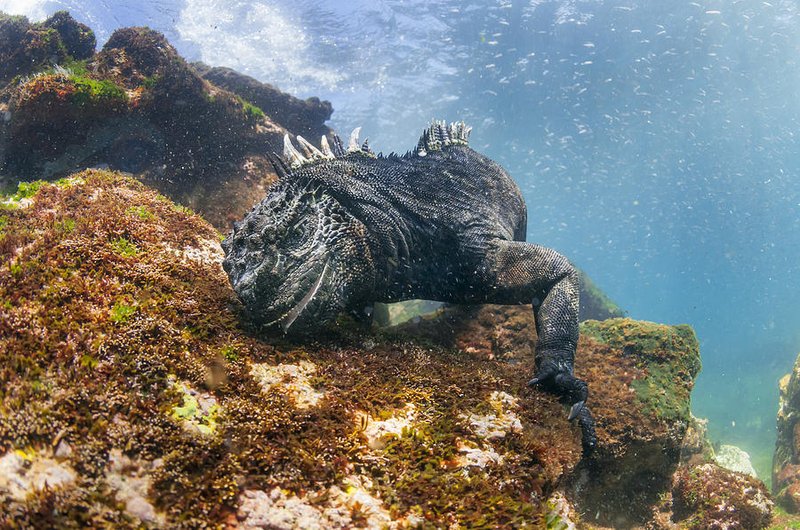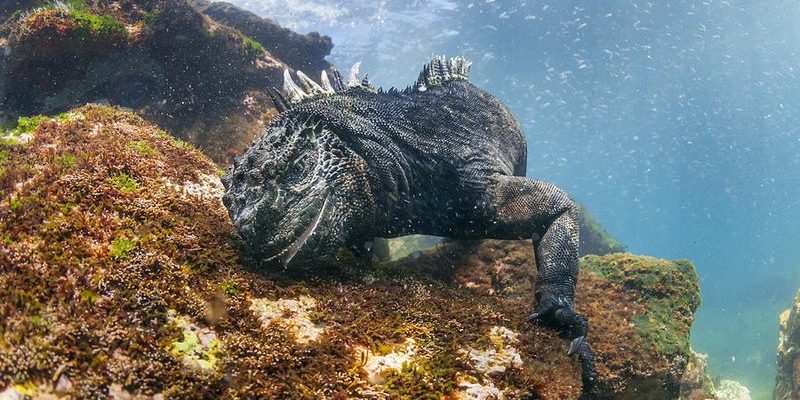
Marine iguanas are not your typical lizards. They’ve developed a diet that’s almost entirely focused on algae found in the ocean. Yes, they’re basically nature’s little seaweed munchers! But there’s a lot more to their hunting style and eating habits than just grazing. In this article, we’ll explore everything from their dietary choices to their unique hunting techniques, and why these traits are vital for their survival.
Understanding the Marine Iguana’s Diet
Marine iguanas have a pretty straightforward menu, but it’s all about quality over quantity. Their primary diet consists of different types of algae. They munch on green, red, and even some brown algae! Each type offers various nutrients, making it crucial for their health. Unlike other iguanas that primarily eat leaves or fruits, marine iguanas have adapted to feast on underwater plants.
Why algae? Well, it’s plentiful, especially in the nutrient-rich waters around the Galápagos Islands. The marine iguana has a unique ability to dive underwater and graze on these algae. They can hold their breath for up to 30 minutes while they dive as deep as 30 feet to find their food. Pretty impressive, right? This specialized diet is key to their survival since they don’t rely on other animals for sustenance.
While algae are their main dish, marine iguanas are also known to occasionally nibble on land plants. They’ll graze on cacti, grasses, and other vegetation when they’re on land or when algae are hard to find. However, this is more of a snack than a substantial part of their diet, as aquatic algae are their primary source of nutrition.
How Marine Iguanas Hunt for Food
So, how do these marine iguanas hunt? Their hunting methods are fascinating and reflect their unique adaptations. When they search for food, marine iguanas use a combination of sight and their sense of smell. They usually hunt alone, but they’re not shy about competing for the best feeding spots.
When they dive for food, they typically do it in an efficient manner. They swim using their powerful tails, which act like propellers, while their limbs are used for steering. As they glide through the water, they actively search for algae-covered rocks and reefs. The hunt for algae is as much about strategy as it is about skill—finding the right area can make all the difference.
Let’s take a moment to talk about their diving technique. Marine iguanas can weigh quite a bit, with some reaching up to 11 pounds. With their heavy bodies, staying buoyant can be a challenge, but they’re built for it! They often take a few deep breaths before diving, allowing them to sink and reach their food. Once they’ve filled up on algae, they float back to the surface, taking in the sun’s rays to warm up—they get a bit cold while swimming!
Adaptations for Eating Underwater
One of the most fascinating aspects of marine iguanas is how their bodies are adapted for a life both on land and in water. Their specialized snouts are perfect for scraping algae off rocks. It’s almost like a built-in spoon! This adaptation is crucial because the algae aren’t just floating around; they cling stubbornly to the surfaces.
Additionally, marine iguanas have sharp, curved teeth that help them grasp the slippery algae. This is a bit different from other reptiles, whose teeth are more suited for tearing meat or crushing plant material. This unique dental design illustrates their specialized diet.
Their bodies also have a built-in method for dealing with salt. Since they consume seawater while feeding, they need to get rid of the excess salt. They have special glands in their noses that help expel the salt, which allows them to stay hydrated without suffering from the effects of too much salt intake. If you ever see a marine iguana snorting, that’s them clearing out their nasal passages!
Feeding Behavior and Social Dynamics
While marine iguanas are solitary animals, their feeding behavior can be quite social. During feeding times, you can often see groups of them hanging out on the same rocks, each one finding its niche. You might think they’d be competitive, but there’s a sort of unspoken order among them.
Larger iguanas often monopolize the best feeding spots, while smaller ones have to wait their turn. It’s a bit like a buffet where the bigger diners take the prime locations, and the smaller ones have to be patient. Honestly, it’s not unusual to see them lined up and waiting for their opportunity to eat. They’re quite the community when it comes to dining!
This social structure helps ensure that everyone gets a chance to eat, even if it means they have to be strategic about when and where they dive for food. Think about it: some creatures hunt in packs, while marine iguanas are more like individuals who occasionally cooperate when it comes to feeding.
Impact of Environment on Diet
The marine iguana’s diet and hunting practices are also heavily influenced by their environment. Changes in ocean temperatures and currents can affect the availability of algae, which in turn impacts their feeding habits. During El Niño events, warmer waters can lead to a decline in algae blooms, making food scarcer.
When food becomes limited, marine iguanas may find themselves diving deeper or venturing further from their usual spots to find sustenance. This can be a real challenge, especially since they’re already working hard to maintain their body temperatures in cooler water. It’s a delicate balance—if the algae isn’t there, their survival is at stake.
You might also wonder how human activity impacts marine iguanas. Pollution and climate change can lead to diminishing algae populations, affecting their food supply. Conservation efforts are vital to ensure that these unique creatures have the resources they need to thrive.
The Importance of Algae in the Ecosystem
You might be surprised to learn that the marine iguana plays a critical role in its ecosystem beyond just being a quirky reptile. By grazing on algae, they help maintain the health of underwater ecosystems. They prevent algal overgrowth, which can suffocate other marine life and disrupt the delicate balance of the ocean environment.
In a way, marine iguanas can be seen as ecosystem engineers. Their feeding habits contribute to the overall health of the marine environment, facilitating nutrient recycling and providing benefits for other species. It’s a symbiotic relationship where they help the ocean thrive while also securing their own food sources.
Moreover, these fascinating creatures serve as indicators of environmental health. By monitoring the populations of marine iguanas, researchers can gain insights into the broader oceanic ecosystem. If their numbers decline, it could signal problems that might also affect other marine life.
The marine iguana is truly a marvel of adaptation with its unique diet of algae and specialized hunting techniques. From their underwater grazing to their social feeding behaviors, these creatures are perfectly crafted for their environment. Their survival hinges not only on their ability to find food but also on the health of their ecosystems.
So next time you think of iguanas, picture these remarkable reptiles diving into the ocean like small, scaly submarines, hunting for their algae snacks. They’re not just surviving; they’re playing a vital role in their environment. Understanding their diet and hunting methods helps us appreciate how interconnected life is, both on land and in the sea. And honestly, isn’t that a pretty cool thought?

